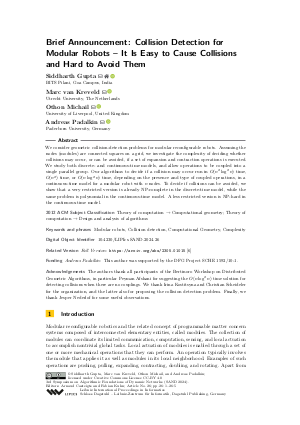@InProceedings{gupta_et_al:LIPIcs.SAND.2024.26,
author = {Gupta, Siddharth and van Kreveld, Marc and Michail, Othon and Padalkin, Andreas},
title = {{Brief Announcement: Collision Detection for Modular Robots - It Is Easy to Cause Collisions and Hard to Avoid Them}},
booktitle = {3rd Symposium on Algorithmic Foundations of Dynamic Networks (SAND 2024)},
pages = {26:1--26:5},
series = {Leibniz International Proceedings in Informatics (LIPIcs)},
ISBN = {978-3-95977-315-7},
ISSN = {1868-8969},
year = {2024},
volume = {292},
editor = {Casteigts, Arnaud and Kuhn, Fabian},
publisher = {Schloss Dagstuhl -- Leibniz-Zentrum f{\"u}r Informatik},
address = {Dagstuhl, Germany},
URL = {https://drops.dagstuhl.de/entities/document/10.4230/LIPIcs.SAND.2024.26},
URN = {urn:nbn:de:0030-drops-199044},
doi = {10.4230/LIPIcs.SAND.2024.26},
annote = {Keywords: Modular robots, Collision detection, Computational Geometry, Complexity}
}

 Creative Commons Attribution 4.0 International license
Creative Commons Attribution 4.0 International license








